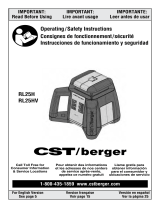
7.2.7 Button lock and double click
The button lock function of the PRA 35 prevents uninten-
tional entries being made and is indicated at the upper left
edge of the display on both sides of the PRA 35. The lock
symbol is either open (unlocked) or closed (locked). In
order to avoid incorrect operation, the “Automatic align-
ment”, “Surveillance” and “Special line” commands must
be confirmed by a double click. For the sake of simpli-
city, this is not mentioned each time in further sections of
these operating instructions.
7.3 Basic functions of the PR 35
The basic functions are horizontal and vertical alignment
plus working with slopes.
7.3.1 Setting the speed of rotation
NOTE
The speed of rotation can be adjusted by pressing the
“Speed of rotation” button (on the control panel of the
rotating laser or on the PRA 35). The speeds of rotation
are: 300, 600 and 1500 /min. The receiver works best
at 600 /min and should not be used at a speed of 1500
/min.
7.3.2 Selecting the line function
NOTE
When the “Line” button is pressed, the rotating laser
projects a line which can be lengthened or shortened by
further presses of the button.
NOTE
With the aid of the PRA 35 laser receiver it is also possible
to stop rotation of the laser and to project a line at the
position of the PRA 35. To do this, move the PRA 35 laser
receiver into the plane of the laser beam and press the
“Special line” button twice (double click).
7.3.3 Moving the laser line
The laser line can be moved to the left or right by pressing
the “Direction” buttons (PR 35 or PRA 35). Holding down
the button results in continuous movement and increases
the speed of movement of the laser line.
7.4 Working in the horizontal plane
7.4.1 Setting up
1. Set up the tool in a suitable position for the applica-
tion, e.g. on a tripod. The angle of inclination of the
surface on which it stands should not exceed ± 5°.
2. Press the “On/off” button.
3. The laser beam switches on and the head begins to
rotate at a speed of 300 /min as soon as the tool
has leveled itself.
7.5 Working in the vertical plane
1. When working in the vertical plane, place the tool
on its metal feet so that the control panel faces
upwards. Alternatively, the rotating laser may also be
mounted on a suitable tripod, wall bracket, facade
adapter or batter board adapter.
2. Adjust the tool so that its vertical axis is positioned
in the required direction.
3. In order to ensure that the tool’s specified accuracy
can be maintained, make sure that it is set up on
a level surface or mounted sufficiently level on the
tripod or other accessory.
4. Press the “On / off” button.
After the tool has leveled itself automatically, it pro-
jects a stationary laser beam vertically downwards.
This projected point is the reference point and is
used to position the tool.
7.5.1 Manual alignment
Manual alignment of the vertical plane is carried out by
pressing the direction buttons (up/down) on the rear of
the PRA 35.
7.5.2 Auto-alignment
Hold the PRA 35 at the point to be aligned, with the
receiving side facing the PR 35, and then press the
“Automatic alignment” button.
The laser plane alignment procedure then begins. A con-
stant signal tone is emitted while this is taking place.
The direction of the search can be changed by pressing
the “Automatic alignment” button.
The alignment procedure can be canceled by a double
click.
As soon as the laser beam strikes the receiving window
of the PRA 35, the beam moves to the position of the
marking notch (reference plane).
A short signal tone is emitted, indicating the end of the
procedure, as soon as the laser beam finds the position
of the marking notch.
7.6 Working with slopes
NOTE
For optimum results, check that the PR 35 is correctly
aligned. This is best done by selecting 2 points each 5 m
to the left and right of the tool but parallel to the tool axis.
Mark the height of the horizontal plane and then, after
setting the slope, mark the heights. The tool is aligned
optimally only when these heights are identical at both
points.
7.6.1 Setting up
NOTE
The slope can be set manually, automatically, or by using
the PRA 76/78 slope adapter.
1. Set up the tool in a suitable position for the applica-
tion, e.g. on a tripod.
2. With the aid of the target notch on the head of the
PR 35, bring the tool parallel to the inclined plane.
3. Press the “On / off” button for at least 8 seconds
until the orange LED lights.
4. The laser beam switches on as soon as the tool has
leveled itself. The PRA 35 can then be set to the
desired slope.
en
25
Printed: 08.07.2013 | Doc-Nr: PUB / 5070219 / 000 / 01





















